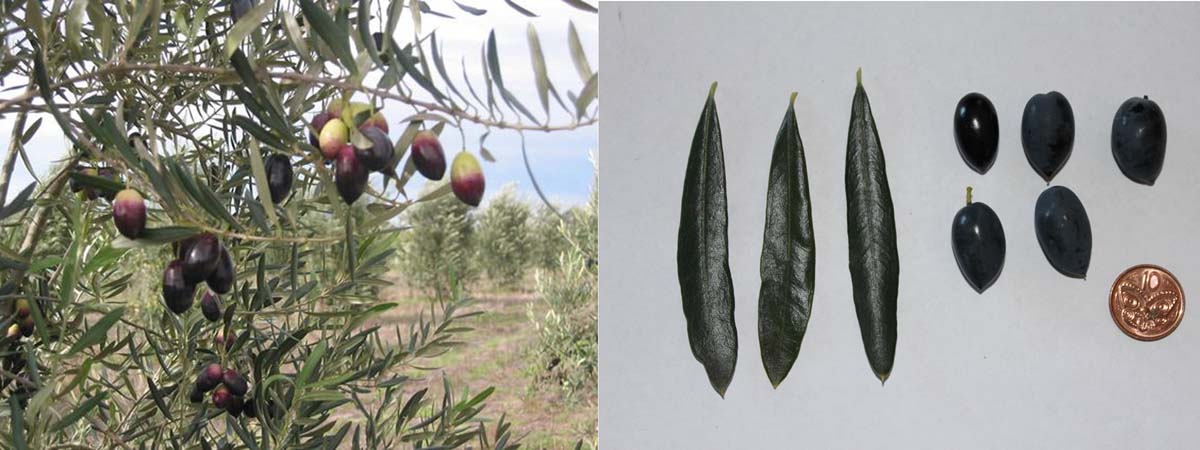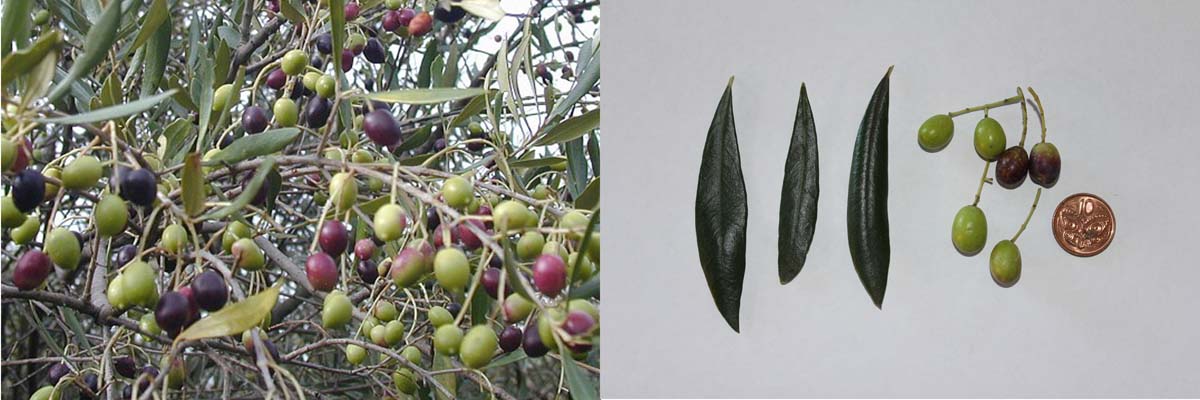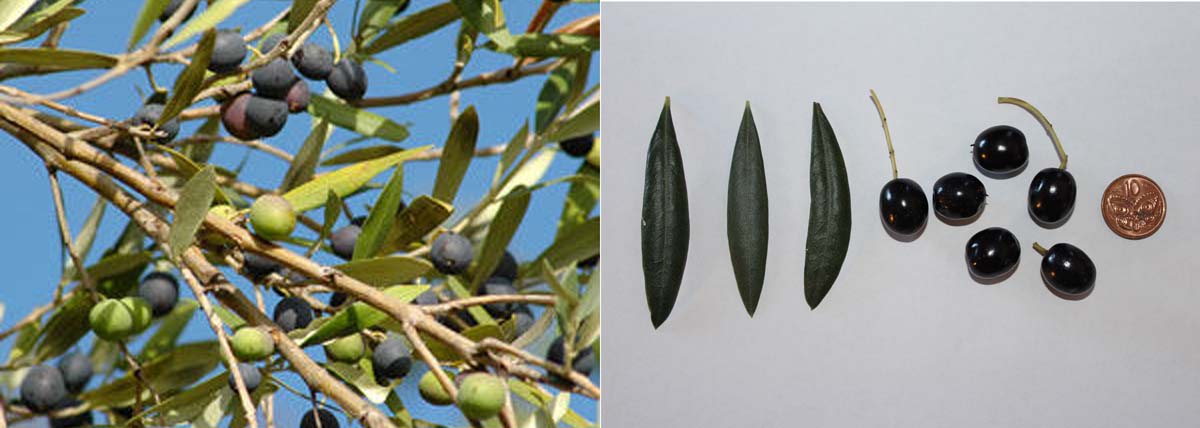Varieties of Olive Trees in Cottage Grove
At least four varieties of olive trees were planted in Cottage Grove at various times. Some trees are at least 10 years old, but others were planted more recently. The professional pruner who manages the trees at 9 Maple Lane has identified all four cultivars on this property. Of these, the variety known as Barnea is the most common. Comments on varietal qualities below are taken from Wikipedia and elsewhere.
 Barnea (origin Israel)
a modern dual-purpose cultivar bred originally from Kadesh Barnea in southern Israel to be disease-resistant and to produce a generous crop. The oil has a strong flavour with a hint of green leaf. Barnea is widely grown in Israel and in the southern hemisphere, particularly in Australia and New Zealand. The photo on the right hand side is of a sample of leaves and fruit of Barnea trees at 9 Maple Lane. Note the sharp pointed end of the large fruit. The leaves are considerably longer than those of the other three varieties in Cottage Grove.
Barnea (origin Israel)
a modern dual-purpose cultivar bred originally from Kadesh Barnea in southern Israel to be disease-resistant and to produce a generous crop. The oil has a strong flavour with a hint of green leaf. Barnea is widely grown in Israel and in the southern hemisphere, particularly in Australia and New Zealand. The photo on the right hand side is of a sample of leaves and fruit of Barnea trees at 9 Maple Lane. Note the sharp pointed end of the large fruit. The leaves are considerably longer than those of the other three varieties in Cottage Grove.
|
 Frantoio (origin Israel) is the main raw material for Italian olive oils from Tuscany. Frantoio is fruity with a strong after-taste.
Slightly nutty flavour to the medium-sized fruit. Self-pollinating, also an excellent pollinator to other olive trees. Good container plant.
The photo on the right hand side is of a sample leaves and fruit of Frantoio trees at 9 Maple Lane.
Note the small size and slightly alongated shape of the fruit. Typically, fruit ripen at various times on the same tree. The leaves are also fairly small.
Frantoio (origin Israel) is the main raw material for Italian olive oils from Tuscany. Frantoio is fruity with a strong after-taste.
Slightly nutty flavour to the medium-sized fruit. Self-pollinating, also an excellent pollinator to other olive trees. Good container plant.
The photo on the right hand side is of a sample leaves and fruit of Frantoio trees at 9 Maple Lane.
Note the small size and slightly alongated shape of the fruit. Typically, fruit ripen at various times on the same tree. The leaves are also fairly small.
|
 Manzanilla (origin Spain) is
a large, rounded-oval fruit, with purple-green skin, which originated in Dos Hermanas, Seville, in southern Spain. Manzanillas means little apples in Spanish. Known for a rich taste and thick pulp, it is a prolific bearer, grown around the world. The variety is cultivated for oil, stuffed fruit, or salted green or black fruit. Self-pollinating. Good container plant.
The photo on the right hand side is of a sample of leaves and fruit of Manzanilla trees at 9 Maple Lane. Note the small leaves and fruit. The fruit are almost spherical in shape.
Manzanilla (origin Spain) is
a large, rounded-oval fruit, with purple-green skin, which originated in Dos Hermanas, Seville, in southern Spain. Manzanillas means little apples in Spanish. Known for a rich taste and thick pulp, it is a prolific bearer, grown around the world. The variety is cultivated for oil, stuffed fruit, or salted green or black fruit. Self-pollinating. Good container plant.
The photo on the right hand side is of a sample of leaves and fruit of Manzanilla trees at 9 Maple Lane. Note the small leaves and fruit. The fruit are almost spherical in shape.
|
 Picual
(origin Spain)
from southern Spain (province of Jaén), is the most widely cultivated olive in Spain, comprising about 50% of Spain's olive production and around 20% of world olive production. It has a strong but sweet flavour, and is widely used in Spain as a table olive.
Picual trees are estimated to account for 25% of all olive oil production in the world.
Picual
(origin Spain)
from southern Spain (province of Jaén), is the most widely cultivated olive in Spain, comprising about 50% of Spain's olive production and around 20% of world olive production. It has a strong but sweet flavour, and is widely used in Spain as a table olive.
Picual trees are estimated to account for 25% of all olive oil production in the world.
This variety is naturally very high in oil content, typically at 20-27% by weight. Virgin olive oil from Picual olives have high levels of polyphenols (an organic compound which is known to have antioxidant effects), typically between 300 and 700 ppm. Many Picual groves are harvested when fully ripe or even overripe to maximise oil content, and thus produce oil with poor taste qualities. As a result, less than one quarter of a harvest would qualify as Extra Virgin. The photo on the right hand side is of a sample of leaves and fruit of Picual trees at 9 Maple Lane. Note the small leaves, and slightly elongated shape of the fruit. |
 The species name of the olive tree is Olea europaea (meaning European olive). It belongs to the botanical family Oleaceae. Formerly the species was mainly distributed throughout the Mediterranean Basin from Portugal to the Levant, but is now widespread throughout the world.
The species name of the olive tree is Olea europaea (meaning European olive). It belongs to the botanical family Oleaceae. Formerly the species was mainly distributed throughout the Mediterranean Basin from Portugal to the Levant, but is now widespread throughout the world.